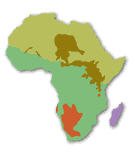 Introduction
Introduction
| Introduction
The Nilo-Saharan language family includes 204 extremely diverse languages. Scholars have argued for over 100 years about the best way to classify them. However, today, most of them accept the genetic unity of the Nilo-Saharan languages as proposed in 1963 by Joseph Greenberg, an American anthropologist and linguist. Ethnologue follows Greenberg's classification by including the following branches of the Nilo-Saharan family. As you can see, the Central and Eastern Sudanic branches account for the majority of these languages (160).
Status
A number of Nilo-Saharan languages became endangered in the 20th century because their speakers adopted other, more prestigious and more widely used languages such as Arabic and Swahili. This is particularly true of languages spoken by fewer than 1,000 speakers. Increased mobility, urbanization, and political upheavals have also contributed to the decline of some Nilo-Saharan languages. Nevertheless, most of them continue to serve as vital means of oral communication for millions of people. Today, the governments of African states are making an attempt to integrate indigenous Nilo-Saharan languages into their educational systems, usually along with official European languages, e.g., English (in Kenya, Nigeria, and Uganda) or French (Chad, Côte d'Ivoire, and Congo) and national languages, e.g., Swahili (in Kenya) and Amharic (in Ethiopia). For instance, in Kenya, Luo and Masai are taught in primary schools along with English and Swahili. In Eritrea, Kunama and Nara are taught in primary schools along with Afaan-Oromo and Amharic. ¡@ | |||||||||||||||||||||||||||||||||||||||||||||||||||||||||||||
|





